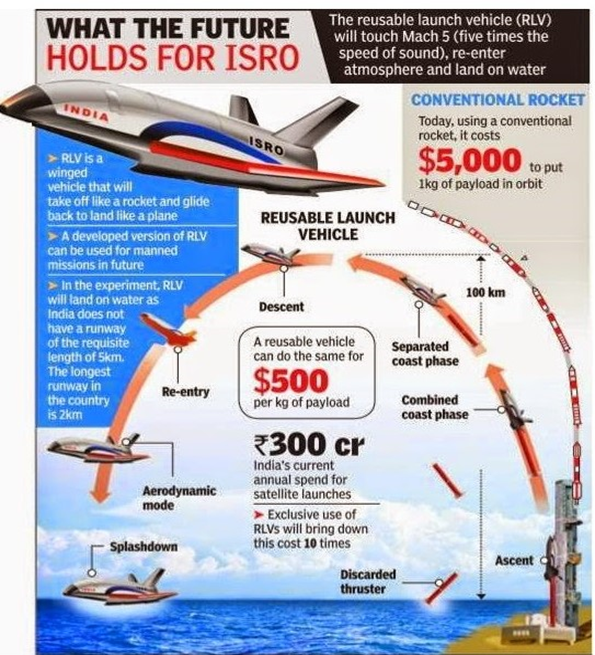Why in News?
- The Indian Space Research Organisation (ISRO) successfully conducted the Reusable Launch Vehicle Autonomous Landing Mission (RLV LEX).
- The test was conducted at the Aeronautical Test Range (ATR), Chitradurga, Karnataka.
What’s in Today’s Article?
- About Reusable Launch Vehicle (Meaning, Usage)
- About RLV LEX (About the Test, Significance of the Test)
- History of ISRO’s RLV Missions (About RLV-TD Programme, Future plans of ISRO for RLV, etc.)
What is a Reusable Launch Vehicle (RLV)?

- Reusable launch vehicle (RLV) means a launch vehicle that is designed to return to Earth substantially intact and therefore may be launched more than one time.
- An RLV may also contains stages that may be recovered by a launch operator for future use in the operation of a substantially similar launch vehicle.
About Reusable Launch Vehicle Autonomous Landing Mission (RLV LEX):
- A Reusable Launch Vehicle (RLV) was flown by a Chinook Helicopter of the Indian Air Force as an underslung load to a height of 4.5 km from the mean seal level.
- The RLV was then released mid-air.
- The RLV then performed approach and landing maneuvers using the Integrated Navigation, Guidance & control system and successfully completed an autonomous landing back on the ATR in Chitradurga, Karnataka.
- The autonomous landing was carried out under the exact conditions of a Space Re-entry vehicle's landing —high speed, unmanned, precise landing from the same return path— as if the vehicle arrives from space.
Significance of the RLV LEX Test:
- This is the first time in the world that a launch vehicle has been carried to an altitude of 4.5 km by a helicopter and released for carrying out an autonomous landing on a runway.
- With the successful landing of RLV LEX, the dream of an Indian Reusable Launch Vehicle arrives one step closer to reality.
History of ISRO’s RLV Missions:
- The cost of access to space is the major deterrent in space exploration and space utilization.
- A reusable launch vehicle is the unanimous solution to achieve low cost, reliable and on-demand space access.
- In line with this aim, ISRO, in 2016, launched the Reusable Launch Vehicle-Technology Demonstration (RLV-TD)
- RLV-TD is India’s first uncrewed flying testbed. It is a scaled down prototype of an eventual two-stage-to-orbit (TSTO) reusable launch vehicle.
- The RLV-TD successfully completed its first atmospheric test flight on 23rd May 2016, which lasted for 770 seconds and reached a maximum altitude of 65 kilometers.
- It was designed to evaluate various technologies, and development of the final version is expected to take 10 to 15 years.
- After the successful execution of RLV LEX, the ISRO is now working on Orbital re-entry Experiment (ORE).
- In ORE, a wing body called Orbital Re-entry vehicle (ORV) will be taken to an orbit by an ascent vehicle derived from the existing GSLV and PSLV stages and stay in orbit for a stipulated period, re-enter and land in a runway autonomously with a landing gear.
- More experiments are in the pipeline to ensure that the RLV succeeds in payload delivery to low earth orbit, as ISRO plans to reduce the cost of the process by 80%.









